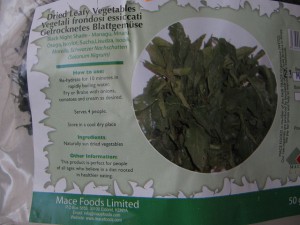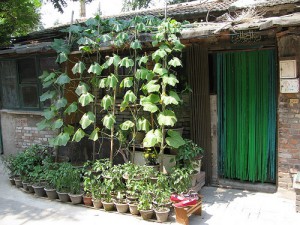- Maintaining a citrus gene bank. Just the book you need if you have to, er, maintain a citrus genebank.
- Guanacos need quiet.
- Don’t understand this piece on maize germplasm conservation and use.
- Indigenous food plants in trouble in the Philippines.
Nibbles: Permaculture, Bird flu, Malnutrition, Roots & tubers in E Africa, Sweet potato
- Perennial fodder crops to the rescue.
- Cool bird flu maps. GIS to the rescue.
- Persistent malnutrition? We know how to fix it. That’s the tragedy. Meanwhile, let’s consult the e-atlas.
- Cassava and potato to the rescue.
- Orange+purple sweet potatoes to the rescue.
Diversity at your service
More from a participant at the 6th Henry A. Wallace/CATIE Inter-American Scientific Conference on “Agrobiodiversity in Mesoamerica — From Genes to Landscapes” at CATIE in Costa Rica.
The ecologists at the Wallace Symposium today waded deeply into the functional role of diversity in agricultural systems. How much diversity do we need in order to get the full benefit of ecosystem services? Is some diversity redundant? What is the trade-off between a world of all things bright and beautiful and one of increased yields, healthy children and growing economies?
Prof. Teja Tscharntke of the Georg-August University in Göttingen presented numerous studies to illustrate the importance of at least a certain amount of wild biodiversity within or in close proximity to agricultural systems. In Andean potato systems, simpler landscapes, lacking heterogeneity in natural habitats, led to higher levels of the pestilential tuber moth and reduction in yields. Coffee systems in Indonesia near natural forest had higher bee species diversity and higher levels of seed set. Hand pollination of cacao had remarkably higher impacts on yields compared to the effects of other major variables, indicating the supreme importance of the near invisible midges that pollinate one of the most revered crops in the world.
But just how much of this wild biodiversity we need, and in what form, are just two of the many questions that are being posed. Teja brought up the SLOSS debate, dating back to the 1970s, of whether single, large or several small reserves will conserve more biodiversity. His findings suggest that many small habitats capture more heterogeneity. Fabrice DeClerck was back with a study of the relationship between species richness and function, using food crops as a model. In a study of households in Sauri in Kenya, he categorized food crops according to the nutrient services they provided — whether high in carbohydrates or proteins or specific vitamins, etc. Not surprisingly, functional richness (i.e. provision of all the major nutrients) was not necessarily associated with the highest species richness. You don’t have to grow everything to get your daily needs of protein and carbs, and for some nutrients (e.g. vitamin C) there is more species redundancy than others (e.g. folates). Well, I guess you had to be there!
The functional role of agrobiodiversity changes as you move from species to landscapes, and few principles can be transported across scales or systems. But that doesn’t stop a little healthy application of diversity when it’s needed. There was a nice case study of the use of plant diversity in and around Costa Rican farms of Dracaena to reduce pest populations that were causing exports of the ornamental plants to be held up by the US quarantine service. Secondary forest or certain types of cover crop can host populations of natural predators to the cicadellid pests. Consequently, the healthy plants passed through quarantine without a hitch and increased Costa Rica’s export revenues.
Nibbles: Ireland, Plumpy’nut, Saola, Food heritage protection, Millet, Wild veggies, Brassica, UNMDGs, Ukraine
- Celebrating the Irish Seed Savers Association celebrations. We had wanted to be there…
- CAS-IP on how to “break” the Plumpy’nut patent.
- Cattle wild relative seen for first time in 10 years. Well, by scientists anyway.
- “Initiatives that merely codify cultural products without taking the social-organizational context into account risk becoming little more than ‘museums of production.'” Ouch.
- Millet domestication pushed back in time.
- Antioxidant properties of traditional wild Iberian leafy greens. Yes, I know, this medicalizes nutrition, but I thought it was interesting that these wild species are still used.
- “…a trait of the diploid species, which apparently looks undesirable, might in fact be highly valuable for the improvement of amphidiploids…”
- “Food? We don’t need no stinkin’ food,” say UN negotiators.
- UK ambassador’s observations on agriculture in Ukraine. Love the contrast between 100 ha fields of sunflowers and the table groaning under home-grown fruit and vegetables.
- In other news, the UK’s ambassador to Ukraine has a blog. And so do a number of others. Sorely tempted to subscribe to their RSS.
On local greens and homegardens and local greens
![]() Great to see two papers by our friends at Bioversity come out in rapid succession recently relating to two project with which I was marginally connected in their early stages back in the 90s. One is on African leafy vegetables (ALV) ((Gotor, E., & Irungu, C. (2010). The impact of Bioversity International’s African Leafy Vegetables programme in Kenya Impact Assessment and Project Appraisal, 28 (1), 41-55 DOI: 10.3152/146155110X488817)), a common subject here. And the other on homegardens ((Galluzzi, G., Eyzaguirre, P., & Negri, V. (2010). Home gardens: neglected hotspots of agro-biodiversity and cultural diversity Biodiversity and Conservation DOI: 10.1007/s10531-010-9919-5)).
Great to see two papers by our friends at Bioversity come out in rapid succession recently relating to two project with which I was marginally connected in their early stages back in the 90s. One is on African leafy vegetables (ALV) ((Gotor, E., & Irungu, C. (2010). The impact of Bioversity International’s African Leafy Vegetables programme in Kenya Impact Assessment and Project Appraisal, 28 (1), 41-55 DOI: 10.3152/146155110X488817)), a common subject here. And the other on homegardens ((Galluzzi, G., Eyzaguirre, P., & Negri, V. (2010). Home gardens: neglected hotspots of agro-biodiversity and cultural diversity Biodiversity and Conservation DOI: 10.1007/s10531-010-9919-5)).
 The ALV paper tries to measure the impact of the work carried out starting in the mid-90s to identify and address key constraints to production and consumption. This is fairly easy to do in terms of research papers published and MSc degrees awarded, but more tricky when it comes to measuring what ALVs mean to the people who eat them. The authors tried to do this through fieldwork at four sites in Kenya. There’s no doubt there has been an increase in ALV production and marketing during the past 10 years, and a significant change in perceptions about these species, which are no longer considered simply “food for the poor.” Their presence in upmarket Nairobi supermarkets is testament to that. What still needs to be verified is that this is leading to significant nutrition and health benefits.
The ALV paper tries to measure the impact of the work carried out starting in the mid-90s to identify and address key constraints to production and consumption. This is fairly easy to do in terms of research papers published and MSc degrees awarded, but more tricky when it comes to measuring what ALVs mean to the people who eat them. The authors tried to do this through fieldwork at four sites in Kenya. There’s no doubt there has been an increase in ALV production and marketing during the past 10 years, and a significant change in perceptions about these species, which are no longer considered simply “food for the poor.” Their presence in upmarket Nairobi supermarkets is testament to that. What still needs to be verified is that this is leading to significant nutrition and health benefits.
A particularly poignant aspect of this study was the way it highlighted the importance of one person, the late Prof. James Chewya of the University of Nairobi, in driving the early ALV work, in particular by influencing young researchers to get involved. Jim is still much missed.
 The homegardens paper is less specifically tied in to the Bioversity project on this topic which began in the early 90s, being essentially a review of the literature of the past couple of decades. ((You can find a copy of the paper on Bioversity’s shiny new website.)) It rehearses the biological features of homegardens, in particular their complexity and diversity, stresses their cultural and socio-economic importance, and describes how these drive each other. The section on the future of homegardens as loci for research and conservation is especially interesting in its juxtaposition of the somewhat different roles of these intensive micro-environments in developing and high-income countries. ((I’ve removed the references in the following quotations to help the flow.))
The homegardens paper is less specifically tied in to the Bioversity project on this topic which began in the early 90s, being essentially a review of the literature of the past couple of decades. ((You can find a copy of the paper on Bioversity’s shiny new website.)) It rehearses the biological features of homegardens, in particular their complexity and diversity, stresses their cultural and socio-economic importance, and describes how these drive each other. The section on the future of homegardens as loci for research and conservation is especially interesting in its juxtaposition of the somewhat different roles of these intensive micro-environments in developing and high-income countries. ((I’ve removed the references in the following quotations to help the flow.))
In developing countries, the nutritional value of local, neglected horticultural species has been assessed and their cultivation in family gardens promoted to guarantee the intake of vitamins and micro-nutrients aiding in the control of HIV infections and other diseases. Establishment of food producing gardens, often based on local seed systems and traditional crops, in areas of explosive urbanization is becoming an important tool for making cities more sustainable while also providing marginal sectors of the population with working opportunities, healthier food and reinforcing their cultural identity.
Well, couldn’t you say much the same of the situation in the US and Europe?
In high-income countries the growing demand for healthier lifestyles and closer connection with nature has driven a renewed interest towards sustainable agricultural systems and ‘‘traditional’’ food products, capable of connecting consumers to the natural and cultural heritage of a community or a geographical region.
True enough, but the ALV experience in Kenya shows that this trend is not confined to places where Slow Food is active. Surely there is more scope for mutual learning.
If there’s one thing that disappointed me a little in reading through these two papers is the seeming lack of cross-fertilization between them. ALV are increasingly common in urban homegardens in Kenya. It would have been nice to see the lessons learned in the course of these two major projects brought together somehow. Maybe something along those lines is in the offing. I hope so. But that is to quibble. It is wonderful to see undervalued species, and the overlooked micro-environments where they often grow, coming into their own.